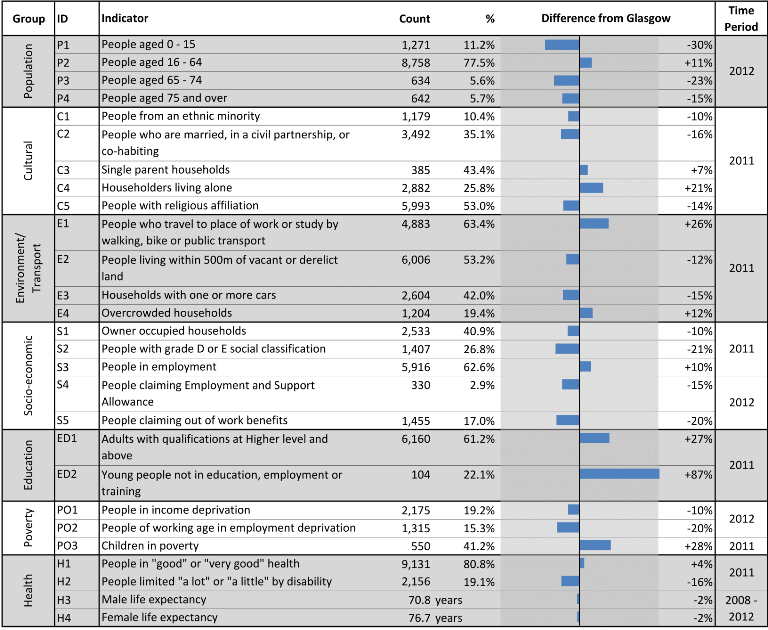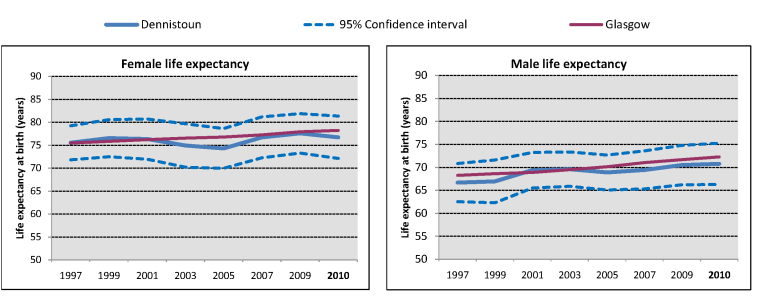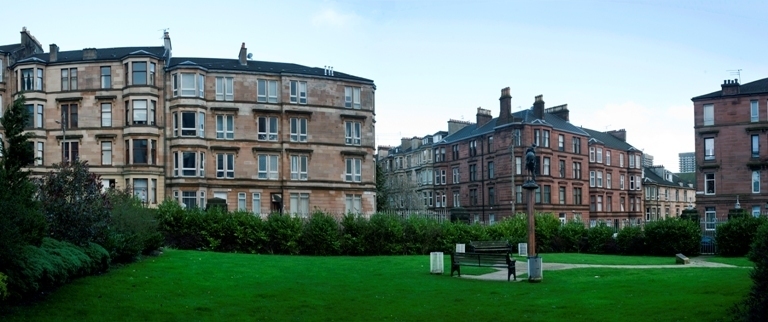Dennistoun
*Please note that this profile is based on data from the 2011 Census.*
A printer friendly version of this sector profile can be downloaded here.
Dennistoun is a neighbourhood in the north east of Glasgow with a population of 11,305.
Neighbourhood comparisons with Glasgow
Estimates of male and female life expectancy in Dennistoun are slightly lower than the Glasgow average. Women live on average for six years longer than men. There is a lower percentage of children (11%) and older people (11%) – defined as aged 65 years and over – in the population than in Glasgow as a whole. Over 60% of people walk, cycle or use public transport to get to work or study. One-fifth of young people are not in education, employment or training. Over 40% of children live in poverty, which is considerably higher than the Glasgow average.
 Neighbourhood trends
Neighbourhood trends
 Life expectancy among men has risen by approximately four years in recent years in Dennistoun. Life expectancy for men and women remains slightly below the Glasgow average and is considerably below the Scottish average.
Life expectancy among men has risen by approximately four years in recent years in Dennistoun. Life expectancy for men and women remains slightly below the Glasgow average and is considerably below the Scottish average.
 The population in Dennistoun increased by 5% between 1996 and 2012, largely due to an increase in the numbers of young adults (16-44 year olds) living in the area. The percentage of the total neighbourhood population from a minority ethnic group increased from 3% in 2001 to 10% in 2011, which is below the Glasgow average but higher than in Scotland as a whole.
The population in Dennistoun increased by 5% between 1996 and 2012, largely due to an increase in the numbers of young adults (16-44 year olds) living in the area. The percentage of the total neighbourhood population from a minority ethnic group increased from 3% in 2001 to 10% in 2011, which is below the Glasgow average but higher than in Scotland as a whole.
Research Links - Dennistoun is one of the case-study areas in a project funded by the Arts & Humanities Research Council (AHRC) which aims "to establish how community representations produced through creative arts practices (e.g. story-telling, performance, visual art) can be used as forms of evidence to inform health-related policy and service development."
Notes
A document giving detailed notes and definitions for the information presented in this profile can be downloaded here.
An Excel workbook containing the data used in all of the profiles can be downloaded here. This workbook also includes alternative output formats and further breakdowns of some of the variables.
1. Data sources: Scottish Index of Multiple Deprivation (SIMD) 2012, Census 2011, Census 2001, HMRC, NOMIS, National Records of Scotland (NRS) and Scottish Government.
2. Populations presented in the population trend chart and used to calculate life expectancy estimates are taken from NRS small area population estimates and are based on: the 2001 Census for the years 1996-2001; both the 2001 and 2011 Census for the years 2002-2010; and the 2011 Census for the years 2011-2012.
3. The Income deprivation and Employment deprivation indicators are derived from SIMD 2012, more information on this deprivation index can be found at: http://simd.scotland.gov.uk/publication-2012
4. Life expectancies are calculated based on population estimates and death registrations. 95% confidence intervals have been added on the graphs to give an indication of their accuracy. The x-axes of the life expectancy graphs give the mid-year for each life expectancy estimate, e.g. 2010 represents the life expectancy estimate for the period 2008-2012.
Glasgow City Council have also produced neighbourhood profiles based on data from the 2011 Census which can be accessed via this link.
